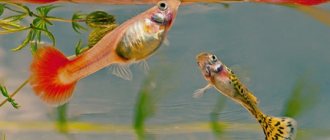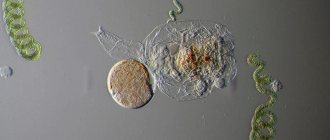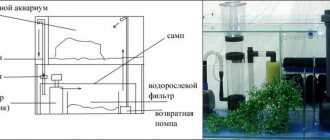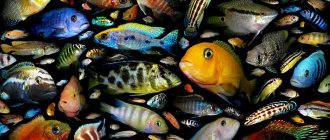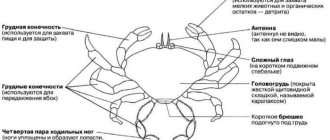Aquarists who understand how important live food is for aquarium fish are beginning to study the types of live food, catching and breeding them. And if you turn to specialized literature, you can find there a considerable list of types of live food for breeding at home. The fish will eat all the proposed types of live food with great pleasure, but what types of organisms: worms, crustaceans and insects are better suited for breeding than others? In theory, all food is suitable, but in reality this is not entirely true.
Daphnia moina
Daphnia moina rectirostris - larva about 0.5 mm, males up to 1 mm, females up to 1.7 mm. Ripen in 3-4 days. They produce up to 7 litters every 1-2 days. There are up to 53 eggs in a clutch. Life expectancy is 22 days. Daphnia moina is a valuable live food for fry and small fish species. Cultivating daphnia is quite simple. For these purposes, an aquarium or simply plastic tanks or three-liter jars are used. You can feed daphnia with baker's yeast dissolved in water, which is added at first until the water becomes slightly cloudy.
Optimal conditions: water temperature from 26 to 30° C, aquarium or tap water, natural or fluorescent lighting, daylight hours of at least 8 hours. The crustaceans are caught with a net made of dense fabric: tulle, veil, organza. Daphnia belongs to zooplankton, that is, to the food that fry eat in nature, so daphnia can be classified as natural food for fry.
Benefits of live food
- Modern dry, frozen, granulated food for aquarium fish is quite nutritious, contains vitamins, is varied, and provides everything you need. But live food contains more protein, vitamins and microelements.
- To produce offspring, some fish species must be fed only live food.
- The fry of all aquarium fish grow much faster when feeding on live food.
- Any packaged products, if they have not been eaten, remain in the aquarium, enter the filtration system, cloud the water and promote the growth of bacteria. Living organisms continue to live until they are eaten by fish.
- If you grow live food yourself, you can control the conditions for obtaining it. These products will not contain bacteria that can cause disease. Live food is an inexpensive way to provide fish with a healthy nutritional supplement. You can not only buy it ready-made, but also grow it yourself at home. Eggs or culture for this are sold in specialized stores.
Let's consider the types of live food that you can get yourself or purchase. They are arranged according to usefulness and nutritional value, from the best to the least nutritious and loved by fish.
Vinegar eel
The acetic eel belongs to a species of roundworms from the family Panagrolaimidae (Turbatrix aceti T. ludwigii and T. Silusae). The acetic eel has additional names: nematode, microfeed, microworm. These worms are dioecious. From the female's body (the eggs take about 8 days to develop), small worms emerge fully formed. They usually reach sexual maturity in a month; the size of adults is 1-2 mm. The main food is vinegar.
Due to the small size of the worms, they can be used to successfully feed the fry of some fish species. The vinegar eel is especially well eaten by the fry of viviparous fish, for example, from the poeciliaceae family: swordtails, guppies, mollies, platies, etc. The eel is bred in low plastic containers with a closing lid or cover glass. So that the worms can breathe, several small 1-2 mm holes are made in the lid or covered loosely with glass.
A low layer of 1.5-2.5 cm of fertilizing made from steamed, porridge-like oatmeal or simply soaked bread is placed in the container and a breeding of worms is added. To increase carotene in the worm, grated carrots are added to the feeding. At room temperature, vinegar eel is diluted very quickly and already on the 5th-6th day you can start feeding it to the fish.
To collect worms, small wide sticks or cubes are placed for feeding, onto which the worms crawl out in large numbers. Collect the worms with a watercolor brush, rinse them in a jar of water and let them sit for 5-10 minutes, then drain the cloudy water and add clean water, and when the water in the jar becomes clear, feed the worms to the fish.
Top 1 - Artemia or sea shrimp
Artemia will undoubtedly take first place among live food for aquarium fish. All types of marine and freshwater fish eat it with pleasure; it is the most nutritious, rich in vitamins and microelements, and easily digestible.
Artemia is a genus of aquatic crustaceans that are found throughout the world and live in salt lakes. Artemia produce so-called dormant eggs or cysts, which is why they have gained wide popularity in the aquarium hobby. Dried brine shrimp eggs have an incredibly long shelf life and can be used at any time to provide a live nutritious food for adult fish and fry.
Artemia nauplii (freshly hatched from crustacean eggs) are necessary food for the rapid growth of fry of any species of fish.
The eggs are placed in salted brine in any container (a glass jar, a jug, or even a plastic soda bottle, but it is recommended to use a container with a concave bottom) and filled with brine.
The brine is prepared using non-iodized salt: 1 tablespoon per liter of water. Some people use Epsom salt mixed with a pinch of baking soda.
The temperature is maintained at around 29 degrees Celsius and a light source needs to be placed above the container. Also, to obtain brine shrimp, be sure to use a compressor - it helps the crustaceans hatch and maintain life.
Once the nauplii hatch, they need to be collected for feeding. Turn off the air supply and let the water settle. The shrimp will settle to the bottom, and the remains of eggs and other debris will float to the surface. Artemia is collected from the bottom using a siphon or syringe.
Grown-up artemia can be fed with green algae, then it will acquire color and become more noticeable to fish.
Larger fish love large artemia, but at home it is almost impossible to grow it to adulthood, it is too troublesome. If desired, you can use a separate aquarium or even a swimming pool for this. To feed the crustaceans, green water and nutrients are added to the water. When the water turns yellowish-green, add crustaceans and wait for them to grow.
The container must be fully or partially illuminated. You can add some brewer's yeast or micro-products to speed up growth.
Pot worms
Potworms (Enchytraeidae) are a high-protein, energy-rich food that is a valuable addition to the overall diet of fish. Aquarists cultivate two species of the simple enchytraeus and the Grindal worm, named after the Swedish scientist Grindal.
(Enchytraeus albidus) are bred in low wooden (birch, beech and other non-resinous tree species, styrofoam, plastic) boxes with a layer of garden soil (small percentage of humus) 8-10 cm. Soil humidity should be at the level of 15-25%. The optimal temperature is 16-20° degrees. The food for pot worms is bread soaked in milk, semolina porridge, boiled potatoes, etc.
Adding yeast to the feed mixture gives excellent results. The fertilizer is placed in holes or furrows once every 3-4 days and sprinkled with earth or covered with glass (for better control over eatability). Daily production can reach 250 g/m². Vitamin A in enchytraeus is up to 0.196 mg%, B2 - 0.134, and carotene - 0.058.
Grindal Worm
Grindal worm - (E. buchholzi) a small (0.5-10 mm) worm, equally suitable for short-term feeding of fry and medium-sized adult fish. Dilution is carried out in glass, plastic or wooden trays with a tightly fitting top lid.
The best substrate would be wet foam plates, as well as boiled or loose pasteurized peat, placed on the bottom in cubes (about 2 cm³). A nutrient medium is placed in the recesses of moistened peat or in the spaces between the plates: yeast mixed with ground oatmeal, oatmeal-based baby food, etc. You can cover the peat cubes with pieces of cheese.
If the cheese becomes moldy, turn it over. You need to feed the worms at least once every 2 days. The optimal temperature for cultivating the Grindal worm is 18−24° degrees. Its selection is carried out by placing a peat cube in a nylon net, through which the worms, when soaked, fall into the water, washing off the food from the substrate, or by collecting the worm in places of accumulation with tweezers.
Grindal remains alive in the water for more than a day. To preserve a large number of enchytraeus, they are transferred to a room with a low (about 0 ° C) temperature, where they are stored in boxes at a density of up to 4-5 kg/m². In this form they are stored for at least 100 days, producing little waste.
A common problem when breeding nematodes
One of the main problems during breeding is mold. This formation indicates non-compliance with the conditions of reproduction, namely:
- substrate consistency is too thin;
- too little starter culture in the environment;
- the temperature is not high enough;
- low-quality nematodes;
- exposure to direct sunlight.
To solve this problem, it is necessary to create a new habitat and carefully follow all the rules during reproduction, namely:
- the consistency of the medium should be thick;
- the temperature should not be lower than 22 degrees;
- Avoid exposure to direct sunlight.
If you have questions or doubts, you should consult with experienced aquarists.
Aulophorus (water snake)
A representative of sea snakes (Naididac), the Aulophorus furcatus worm, which in nature inhabits the thicket zone of ponds, lakes and rivers, feeding on rotting algae, dying plants, silt and other available organic matter, will be a good help in a home feed shop.
Maximum length 2 cm, thickness 0.2 mm. Hermaphrodite, most often reproduces by division. Unlike the tubifex, it does not make respiratory movements, concentrating in small balls in different places of the aquarium. To obtain a pure culture, natural samples are sorted under a microscope or a tripod magnifying glass. Worms are grown in a low (up to 20 cm) rectangular vessel with aeration and a cover glass.
A floating foam plastic feeder covered with nylon (No. 64) is placed on the surface of the water. Once every 2-3 days, feed is placed in it - well-sifted grass meal or algae-yeast paste. In 10 days at a temperature of 24-28° degrees, the biomass of worms doubles. Every day you need to change half the volume of water. The signal for a change is the grouping of worms along the water's edge. At this point it is convenient to collect them for feeding fish. Cut aulophorus is well eaten by 5-day-old fry.
Fruit fly (Drosophila)
The fruit fly (Drosophila) is a genus of insects in the fruit fly family. Small insects (up to 3.5 mm long) with a swollen body and usually red eyes. Fruit flies are found everywhere and are especially common in vegetable and fruit stores.
The larvae develop primarily in fermenting, often semi-liquid plant debris. For home breeding it is better to use the wingless form. Fruit flies are well suited as food for medium and large fish that forage in the upper layers of water.
Drosophila cultivation is very easy. You can use any fruit as food for them, and an ordinary three-liter jar is suitable for the incubator. After placing a 2-3 cm layer of chopped or grated apples on the bottom of the jar and waiting for flies to fly into the jar, cover the neck of the jar with gauze. Fruit flies enclosed in a jar begin to multiply rapidly.
During the first 3-4 days they actively lay eggs, then after 2-3 days voracious larvae appear, which on the 2-3rd day, clinging to the walls of the jar, turn into cocoons, from which on the 3-4th day fully formed fruit flies emerge, forming a numerous swarm in the jar. Before feeding, the fruit flies are moved to a new jar by removing the gauze from the first and placing the second on top. The flies quickly move to a new jar from where they will need to be shaken out into the aquarium for the fish to eat.
Bloodworm
The high protein content (60%) makes mosquito larvae the most valuable type of food. Bloodworms are bright red in color and size from 0.5 to 2.5 cm. Lake specimens are larger than larvae caught in the river. Their habitat is bottom and silt sediments of rivers, standing water of lakes and ponds.
Purchase
When purchasing bloodworms, you should pay attention to the following:
- The color should be deep red. The pink color indicates the immaturity of the larvae, which means they will be inactive, less nutritious and will die quickly. A dark burgundy color is a signal that the bloodworm was caught a long time ago and cannot be stored for long. The risk of fish poisoning increases.
- Different sizes of individuals in one batch (from 1 to 7 mm), different colors from carrot to dark red indicate that the bloodworms were collected in estuaries. This species has less nutritional value due to its too thick chitinous layer.
- The mobility of the larvae indicates the freshness of the product. Fresh bloodworms are very mobile; if you disturb them, they begin to curl into rings.
Storage
Storage rules:
- the purchased food is washed several times with running water;
- dead larvae are removed;
- the batch is divided into small portions, which are wrapped in damp cloth;
- The packages are stored in the refrigerator.
Experts advise that before feeding the fish, keep the bloodworms for 3 days so that they empty the intestines of the eaten organic food.
Feeding
When feeding, certain conditions are met:
- the bloodworm must be alive and active; dead larvae can poison the fish;
- food should not fall into the ground; when buried, it becomes inaccessible to the inhabitants of the aquarium, then dies and spoils the soil;
- The larvae are not cut, otherwise their contents will quickly pollute the water.
To meet these conditions, bloodworms are fed into the aquarium through special feeders that have holes, and only a living larva can crawl through them. The bloodworm slowly climbs out of the feeders and the fish manage to eat it before it falls to the bottom. To feed bottom fish, clear part of the soil and make sure that bloodworms do not leave this area.
Freshwater brachionus
Freshwater brachionus (Br. calyciftorus) has a larva measuring 0.1−0.3. Ripens per day and has a lifespan of 4−17 days. Temperature optimum 22−32° degrees. The female gives up to 20 litters, laying 6-12 eggs every 12 hours.
Feed: dry hydrolytic yeast at the rate of 2 g per 100 l. Rotifers grown on algae are much more nutritious and even juvenile coral fish can be successfully raised on them.
Top 3 – Pipemaker
Among hobbyists, Tubifex is considered one of the best foods for quickly raising fry, and it is also good for feeding adult fish, although it is considered not the best food due to its insufficient vitamin content and high fat content. In terms of nutritional value, it occupies the next place of honor after brine shrimp and bloodworms.
The tubifex is quite common, it can be easily found on sale and can be kept at home for a long time. There is an opinion that it is also possible to breed tubifex at home, but this is too labor-intensive a process that does not guarantee results.
The tubifex is a reddish worm up to 3-8 cm long. In nature, it lives in the muddy soil of reservoirs at shallow depths closer to the shore, where the silt is closer to the surface of the water. In such places, the water is sufficiently saturated with oxygen, and the worms are more protected from fish.
The fry are fed the smallest or chopped worms. Adult fish easily swallow the worm whole.
At home, worms can be stored for several weeks. For this you need a low tray. The acquired culture must be washed several times with dechlorinated water until it is clear. The washed worms are filled with water drained from the aquarium, the compressor tube is lowered into the tray and turned on. Store tubifex at room temperature.
After just 12 hours, the water in the tray becomes cloudy, and the tubifex culture is washed again. You need to repeat the procedure twice a day, and do not forget to use dechlorinated water, and after the procedure, turn on the aeration of the water.
Before feeding the fish, add 5 drops of acriflavine to a glass of clean water, and dip a selected batch of worms into this water for feeding. This is necessary in order to disinfect the tubifex and prevent the fish from becoming infected with possible diseases. Shake the worms and leave for 15 minutes to process. Then the solution is drained and the tubifex is washed with water until the worms are cleared of the solution. After this you can feed the fish.
Grain moth caterpillars
Caterpillars of grain moth (Nemapogon grannelus - size about 10 mm), miller moth (Ephestia kbehiella) and mealworm (Tenebrio molilor) can be bred in any glass or plastic containers covered with gauze on top.
Feed - bran, semolina, etc. layer 2-3 cm. It is useful to add carrots, cabbage leaves, nettles. Insectivorous fish (squirters, butterflies, mudskippers, etc.), as well as barbs, cichlids, and uaru eat this food well.
Blank
The appearance of the food photo can be enlarged
When harvesting in bulk, the top part of the soil along with the worms is cut off using a shovel or scoop into a basin or bucket. Then the sludge can be washed under running water or, which is easier, put gauze on top and warm the vessel from below over low heat or with hot water. To escape the heat, the worms will crawl up through the gauze, where they can be easily collected. In this case, it is easier to wash them.
Earthworms
Among the annelids, the ones of greatest interest to aquarists are earthworms, tubifex worms and enchytraeus. There are over 50 species of earthworms (Lumbricus) in the CIS. They are all hermaphrodites, but use cross-fertilization. From 1 to 10 embryos develop in the laid cocoon.
Under optimal conditions, there can be over 400 worms per 1 m³ of land. Their main food is organic compounds from the soil. The most tenacious and nutritious worms are those that live in humus (manure), where they reproduce in large quantities. Harvested worms can be stored for several months in a cool place in a wooden box covered with a lid with ventilation holes.
The substrate for them is wet moss, turf, humus with leaves, and the top dressing is corn flour. Before feeding, the worms are kept for 1-2 days in order to empty their intestines of contents (you can squeeze it out, but this is more labor-intensive), washed from mucus and, if necessary, crushed.
Feeding the fish
Nematodes can be used as main food and bait. They are mainly used to feed fry, since they are not very nutritious for adult fish. To increase the nutritional level, nematodes must be mixed with special food or vitamins.
After washing, the nematodes are either poured into the aquarium along with the remaining clear water, or collected in a syringe and then released near the aerator. This is done so that the worms are evenly distributed throughout the space. After feeding, it is necessary to replace 10% of the water or simply catch the excess.
Nematodes can live for several days in an aquatic environment, which means that the amount of food must be strictly observed. To do this, you need to monitor how long it takes for the fry to eat the worms, as nematodes can cause water pollution and develop bacteria that can harm the fish.
Diaptomus (Cyclops)
Of the copepods, Cyclops (from 1 to 5.5 mm) and Diaptomus (12-5 mm) are of interest. The former have whiskers shorter than the body and make continuous jumping movements, the latter “hover” in the water, occasionally moving with the help of long first antennae, 4 pairs of swimming legs and partly oral limbs.
Diaptomus feed on diatoms and protococcal algae. Their larvae are the best food for fry of glass perch, brachytobius and other passively feeding fish. Copepods grow and reproduce more slowly than daphnia. From the egg sacs of females, larvae emerge - nauplii, which, together with rotifers, form “living dust”. When feeding fry with cyclops, one should take into account their mutual proportionality and the density of crustaceans, since the latter are capable of attacking fry and even destroying them.
Artemia
Artemia is a small crustacean that lives in saltwater reservoirs. Adult brine shrimp reach a size of 8-10 mm, but in aquariums they usually use nauplii - newly hatched small larvae, which are an excellent first food for the fry of many fish.
A huge advantage of Artemia is its ease of cultivation. To do this, you only need a small vessel with salted water and a compressor. Home-grown brine shrimp does not carry pathogens and, of the live foods mentioned above, is perhaps the only safe one.
As for bloodworms, coretra and tubifex, they are definitely not such, and before feeding fish with them, they must be disinfected.
It is not recommended to use brine shrimp as a permanent feed due to its high calorie content, which can lead to fish obesity.
Streptocephalus crustacean
Of the freshwater counterparts of Artemia, the shell crustaceans that are most interesting from a nutritional point of view are the pinkish cisicus, leptesteria and the half-centimeter linceus - typical inhabitants of puddles. Adult crustaceans eat detritus, small plankton, and algae-eating larvae.
Let's take a closer look at the streptocephalus branchiopod (Streptocephalus torvicornis), which inhabits temporary reservoirs (beam ponds, etc.) of the steppe Ukraine, Volgograd and Saratov regions. Its abdomen is devoid of limbs and consists of 9 segments (Artemia has 8), the maximum length is 3 cm. Mature crustaceans and eggs are harvested in the summer-autumn period.
The sludge along with the eggs is dried and stored in a cool room. Streptocephalus is cultivated in crystallizers or aquariums with fresh soft water at a layer of 30-40 cm. The eggs should cover no more than 1 cm of the bottom surface. Optimal conditions; dH 2-6°, pH 6.8-7.2, t 15-20° degrees (max. 25° C). The first larvae hatch after 1.5-2 days, the mass emergence occurs on the 4-7th day.
Their food will be bacterial, yeast cells (0.1-0.5 million/ml), chlorella, protococcal algae (0.5-0.8 million/ml). After adding algae paste, the water takes on a light green color. Yeast is diluted to the concentration of diluted milk and set with a pipette - 2 drops/ml, or 4 cm³ per 100 l. Juveniles are pale pink in color, adults are greenish or brown, starving crustaceans become white with black spots on the chest legs. On the 5th day of life, the size of the crustaceans is about 2 mm, on the 15th - up to 9 mm, on the 25th - 16 mm.
The ripening of crustaceans occurs on the 25-35th day, their density during this period should not be more than 25-75 specimens/l. Reproduction is carried out sexually. During her life (in 2-2.5 months), the female lays 25-27 portions (in the first 15-120, later up to 600 eggs). The interval between clutches is 5-7 days. Eggs can be easily separated from excrement by agitation or centrifugation. To extend the life of eggs during long-term storage, drying is carried out in silt or on quartz sand.
Pristicephalus Josephine
No less promising is the inhabitant of small forest ponds - Josephine's Pristicephalus josephinae. Its size is 14-30 mm. The female’s productivity is up to 300 eggs, the average diameter of which is about 0.25 mm. Of great importance is the cultivation of those species of branchiopods whose development begins at low temperatures: Branchinecta paludosa, Polyartemia forcipata.
If you have open decorative pools at your summer cottage, you can significantly diversify the food supply with the help of a simple device. A portable reflector is mounted above the surface of the pool and turned on at night. Thus, only due to the insects that have flown into the world, the need of fish (spawning cyprinids, cyprinids, etc.) for high-quality feed is fully satisfied.
For feeding purposes, cockroaches (Blatella, Blaberus, Periplaneta, etc.), crickets (Acheta domectica), and stick insects (Carausius morosus) are bred in animal and plant environments. If necessary, I inject vitamins, microelements, etc. into insects before feeding.
Blowfly larvae (maggots)
The larvae of blowflies - maggots (Calliophoridae) can be easily obtained by exposing spoiled meat, etc., in the warm season. As they grow, they can be given to fish of different sizes. Before feeding, the selected larvae are kept on cottage cheese for 2-3 days. Store maggots for up to 10 days in dry sawdust.
As you can see, the presented list of live food for aquarium fish is huge. But it’s unlikely that anyone will breed: grain moth caterpillars, mealworms, fungus gnat larvae, crickets and cockroaches. But you can try to breed other live food for aquarium fish: freshwater Brachionus, Aulophorus, Daphnia, Grindal worm, freshwater Artemia crustaceans - Cisicus, Leptesteria, Linceus and inhabitants of small forest ponds - Pristicephalus.
Advantages and disadvantages
Advantages:
- Contains high-quality, easily digestible protein.
- Movable This is important for fry and some predatory fish species that feed exclusively on moving objects.
- Minimally pollutes the aquarium.
Live food is useful for aquarium inhabitants
Disadvantages:
- There is a high risk of poisoning if it was collected in environmentally unfavorable places, for example, in city ponds.
- A carrier of infections or parasites.
- Requires daily measures to preserve food in a form suitable for feeding.
It is better for inexperienced aquarists not to give live food to fish, since there is a high risk of improper use and, as a result, death of the inhabitants of the aquarium.
